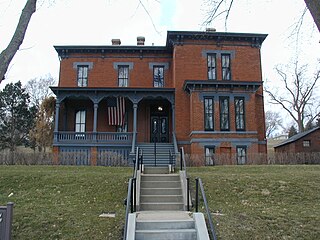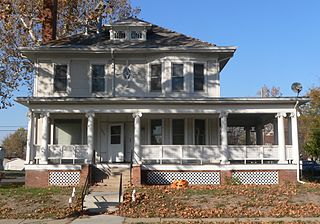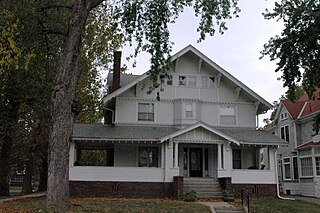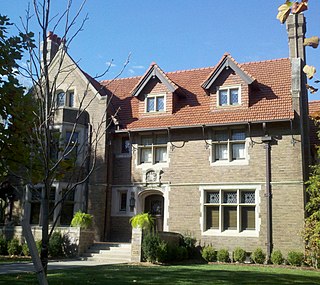
Omaha is the largest city in the U.S. state of Nebraska and the county seat of Douglas County. Omaha is in the Midwestern United States on the Missouri River, about 10 mi (15 km) north of the mouth of the Platte River. The nation's 39th-largest city, Omaha's 2020 census population was 486,051.
Robert Todd Storz headed a very successful chain of American radio broadcasting stations and is generally credited with being the foremost innovator of the Top 40 radio format in 1951. The selection of records to be played was based on sales reported by record stores, an indication as to which would be of greatest interest to listeners. Only the favorites would be played, in rotation. Some sources also credit his Omaha radio station as among the first to play at least some rock and roll records.
Significant events in the history of North Omaha, Nebraska include the Pawnee, Otoe and Sioux nations; the African American community; Irish, Czech, and other European immigrants, and; several other populations. Several important settlements and towns were built in the area, as well as important social events that shaped the future of Omaha and the history of the nation. The timeline of North Omaha history extends to present, including recent controversy over schools.
Saratoga Springs, Nebraska Territory, or Saratoga, was a boom and bust town founded in 1856 that thrived for several years. During its short period of influence the town grew quickly, outpacing other local settlements in the area including Omaha and Florence, and briefly considered as a candidate for the Nebraska Territorial capitol. Saratoga was annexed into Omaha in 1887, and has been regarded a neighborhood in North Omaha since then.

The history of Omaha, Nebraska, began before the settlement of the city, with speculators from neighboring Council Bluffs, Iowa staking land across the Missouri River illegally as early as the 1840s. When it was legal to claim land in Indian Country, William D. Brown was operating the Lone Tree Ferry to bring settlers from Council Bluffs to Omaha. A treaty with the Omaha Tribe allowed the creation of the Nebraska Territory, and Omaha City was founded on July 4, 1854. With early settlement came claim jumpers and squatters, and the formation of a vigilante law group called the Omaha Claim Club, which was one of many claim clubs across the Midwest. During this period many of the city's founding fathers received lots in Scriptown, which was made possible by the actions of the Omaha Claim Club. The club's violent actions were challenged successfully in a case ultimately decided by the U.S. Supreme Court, Baker v. Morton, which led to the end of the organization.
Architecture in Omaha, Nebraska, represents a range of cultural influences and social changes occurring from the late 19th century to present.

The General George Crook House Museum is located in Fort Omaha. The Fort is located in the Miller Park neighborhood of North Omaha, Nebraska, United States. The house was listed on the National Register of Historic Places in 1969, and is a contributing property to the Fort Omaha Historic District.

The Gold Coast Historic District is located in Midtown Omaha, Nebraska. Listed on the National Register of Historic Places in 1997, this historic district covers approximately a 30 block area roughly bounded by 36th, 40th, Jones, and Cuming Streets. The neighborhood housed many of Omaha's cultural and financial leaders between 1900 and 1920, taking over from Omaha's original Gold Coast in prominence.

The George H. Kelly House is located at 1924 Binney Street in the Near North Side neighborhood of Omaha, Nebraska, United States. Built in 1904 in the Neo-Classical Revival style, it was listed on the National Register of Historic Places in 1983, and designated a City of Omaha architectural landmark that same year.

The Charles Storz House is located at 1901 Wirt Street in the Kountze Place neighborhood of North Omaha, Nebraska. The Arts and Crafts style house was designed by the Omaha architectural firm of Fisher and Lawrie and built in 1909. In 1983 it was renovated as a historic preservation project involving the National Trust for Historic Preservation, Landmarks, Inc., the City of Omaha and the Consumer Services Organization. In 1984 it was designated an Omaha Landmark.

Little Bohemia, or Bohemian Town, is a historic neighborhood in Omaha, Nebraska. Starting in the 1880s, Czech immigrants settled in this highly concentrated area, also called "Praha" (Prague) or "Bohemian Town", bounded by South 10th Street on the east, South 16th Street on the west, Pierce Street on the north, and Martha Street on the south, with a commercial area went along South 13th and South 14th Streets, centered on William Street. It was located south of downtown, and directly west of Little Italy. A portion of the neighborhood along South 13th Street was listed on the National Register of Historic Places in 2020.

The Dr. Samuel D. Mercer House was built in 1885 in the historic Walnut Hill neighborhood of Omaha, Nebraska, United States. Samuel Mercer was the chief surgeon of the Union Pacific Railroad, and the founder of Omaha's first hospital.

The Prague Hotel is located at 1402 South 13th Street on the southwest corner of South 13th and William Streets in the heart of the Little Bohemia neighborhood of Omaha, Nebraska. Designed by Joseph Guth and built in 1898, this building was listed on the National Register of Historic Places in 1987.
Gottlieb Storz (1852–1939) was a pioneer entrepreneur in Omaha, Nebraska. Born in Benningen, Wurttemberg, Storz was the founder of the Storz Brewery. He was an important member of Omaha's German immigrant community, and an important businessman in Omaha history. Storz was regarded as a "giant in the brewing world".
The Storz Brewing Company was located at 1807 North 16th Street in North Omaha, Nebraska. Established from a company started in 1863, Storz Brewing began in 1876 by Gottlieb Storz and was owned by the Storz family until 1966; the brewery ceased operations in 1972. Their beers won several prizes in international competitions, and Storz was the top selling brand in Nebraska starting in World War II. Storz was one of the "Big 4" brewers located in Omaha, which also included the Krug, Willow Springs and Metz breweries. On August 8, 2013, it was announced the brand would be revived by Tom Markel, nephew of Monnie Storz Markel, the granddaughter of Gottlieb Storz, with his cousin John Markel, son of Monnie Storz Markel as investor.

Gurdon Wallace Wattles was an early businessman, banker, and civic leader in Omaha, Nebraska, who became responsible for bankrolling much of early Hollywood. Wattles was said to possess "all the right credentials to direct Omaha's fortunes for the twentieth century in the post-pioneer era: humble beginnings, outstanding ability, a fine intellect, impeccable manners, driving ambition, and a ruthless streak."

The Brandeis–Millard House is located in the West Farnam neighborhood, which is part of the Gold Coast Historic District in Midtown Omaha, Nebraska. Its carriage house is located at 3815 Dewey Avenue in the same area. Listed on the National Register of Historic Places in 1980, it was designated an Omaha Landmark on June 10, 1986.
South 10th Street is a two-way street that runs south-north from Downtown into South Omaha, Nebraska. Beginning at Dodge Street, South 10th Street passes Gene Leahy Mall and borders the ConAgra Campus and the Old Market. Its southern reaches are widely regarded as the heart of Little Italy, and further south it was the center of the Old Gold Coast neighborhood. There were several other historically ethnic communities, as well.

St. Martin of Tours Episcopal Church is a historic stone Episcopal church building located at 2312 J Street in the South Omaha district of Omaha, Nebraska. Built in 1899 in the Late Gothic Revival style, it was designated an Omaha Landmark and listed on the National Register of Historic Places in 1982. It was the first Episcopal church established in South Omaha when the town was being developed. It is the only surviving Episcopal church in this community, which was settled chiefly by Catholic immigrants.













